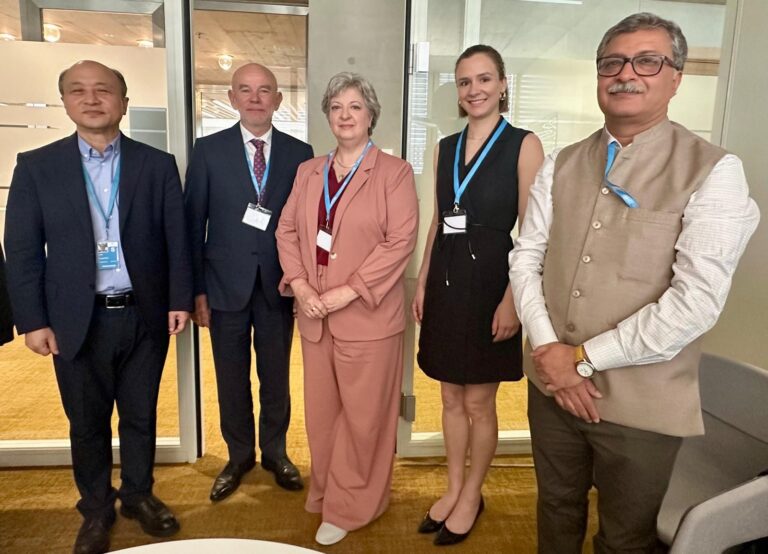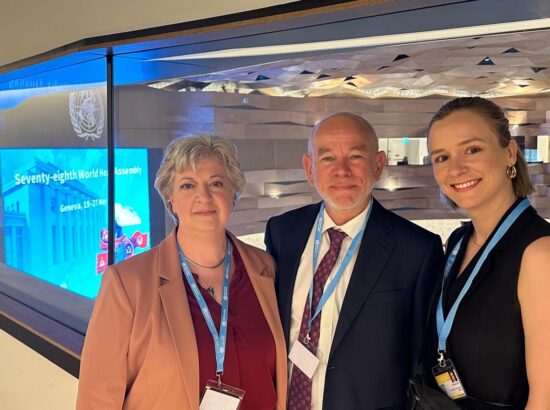Thursday, November 6, 2025
There is no greater advocate for osteopathy and osteopathic medicine than Kendi Hensel, DO, PhD, FAAO, and professor at UNT Health Fort Worth’s Texas College of Osteopathic Medicine, and she is now leading the effort to organize a task force with the World Health Organization to develop the first Technical Report for Training and Practice in Osteopathy and Osteopathic Medicine worldwide.

UNT Health TCOM's Dr. Kendi Hensel, Associate Professor, Family Medicine and Osteopathic Manipulative Medicine
Hensel is the chair-elect for the Osteopathic International Alliance – the only organization representing the global osteopathic profession in “official relations” with the WHO (since 2018) – and will become the chair of the organization in November of 2026. She traveled to Geneva, Switzerland, in May to meet with officials from the WHO to begin the process of the agreement, so the work of nominating task force members can proceed.
The WHO develops and publishes various technical standards and guidelines to ensure the quality, safety, and efficacy of health products and practices globally. These standards cover a wide range of areas, including medical devices, pharmaceuticals, vaccines, and digital health technologies.
“Moving forward with the WHO is a big accomplishment,” Hensel said. “Osteopathy around the world is different than what we know as Osteopathic Medicine in the United States. In other countries where the profession is not regulated, someone can attend a weekend course and call themselves an osteopath and open a practice. The purpose of these reports will be to provide clarity and help countries achieve regulation and standardization of osteopathic practice.”
The OIA will collaborate with the WHO to assemble a task force that will have 10-15 experts from around the world who will draft technical standards and incorporate feedback regarding terminology for Osteopathy that is being proposed by the OIA Glossary Task Force.
 “This is going to be a fairly lengthy process because members of the OIA can’t just
write the reports,” Hensel said. “We will help identify experts in the US and other
countries and show this is a legitimate and viable profession that needs to be recognized.
We are working on glossary terms and defining those terms to make sure they are clear
and consistent.”
“This is going to be a fairly lengthy process because members of the OIA can’t just
write the reports,” Hensel said. “We will help identify experts in the US and other
countries and show this is a legitimate and viable profession that needs to be recognized.
We are working on glossary terms and defining those terms to make sure they are clear
and consistent.”
The WHO constructs technical standards as well as reports in various areas. How the WHO develops these standards includes expert committees, research and data collection, harmonization and collaboration. The committees will develop and revise specific recommendations for various health products and practices, and then the WHO will base its standards on research conducted by experts and data collected from diverse countries and populations. The development of the technical reports/briefs for training and practice in osteopathy and osteopathic medicine will follow a similar process.
The WHO will aim to harmonize guidelines and recommendations for use by manufacturers and regulatory authorities worldwide and then collaborate with them and other organizations to ensure the standards are implemented effectively. In essence, WHO technical standards play a crucial role in promoting global health by establishing benchmarks for quality, safety, and effectiveness in healthcare practices and products.
Currently, there is a standard for Training in Osteopathy, but not for Osteopathic Medicine, and no standards for Practice in either.
“In almost all other countries, Osteopaths are not physicians,” Hensel said. “The hope is to help eliminate the ambiguity. If somebody in an unregulated country says I’m going to start to practice osteopathy, then they start treating people with very little knowledge or training and harm is done to that patient, this will affect our entire profession because the perception will be that osteopathy and osteopathic medicine hurt the patient. We want to make sure there are minimum standards in place globally, and patient safety is certainly part of the goal, but so is public health.”
In 2020, the OIA released a report on the number of osteopaths worldwide. There were 79,302 osteopaths outside of the United States; of these, 45,093 are statutorily regulated and registered osteopaths, and it was estimated that 34,207 osteopaths are not statutorily regulated and registered, but may be registered with voluntary registering organizations.
 Osteopathic physicians can obtain a license to practice medicine in 57 states. Osteopaths
were statutorily recognized as healthcare professionals and regulated by law in 13
countries, and in 22 countries, Osteopathy is either not recognized or regulated by
governmental statute, where registration is voluntary.
Osteopathic physicians can obtain a license to practice medicine in 57 states. Osteopaths
were statutorily recognized as healthcare professionals and regulated by law in 13
countries, and in 22 countries, Osteopathy is either not recognized or regulated by
governmental statute, where registration is voluntary.
The entire process to construct the reports could take up to two years or longer, but the desired outcome is clear.
“We want to elevate the standard for osteopathic training around the world so that every patient will have access to a well-trained osteopathic physician or osteopath,” Hensel said. “These are two streams of the same profession, osteopathic medicine and osteopathy, but A.T. Still is still the father of both.”
The OIA was launched in June 2003 and today represents 76 organizations from 20 countries across five continents. Hensel, first elected to the OIA’s Board of Directors in 2022, is the first representative of TCOM and UNT Health to serve as chair-elect or chair.
From UNT Health Newsroom - Community by Steven Bartolotta